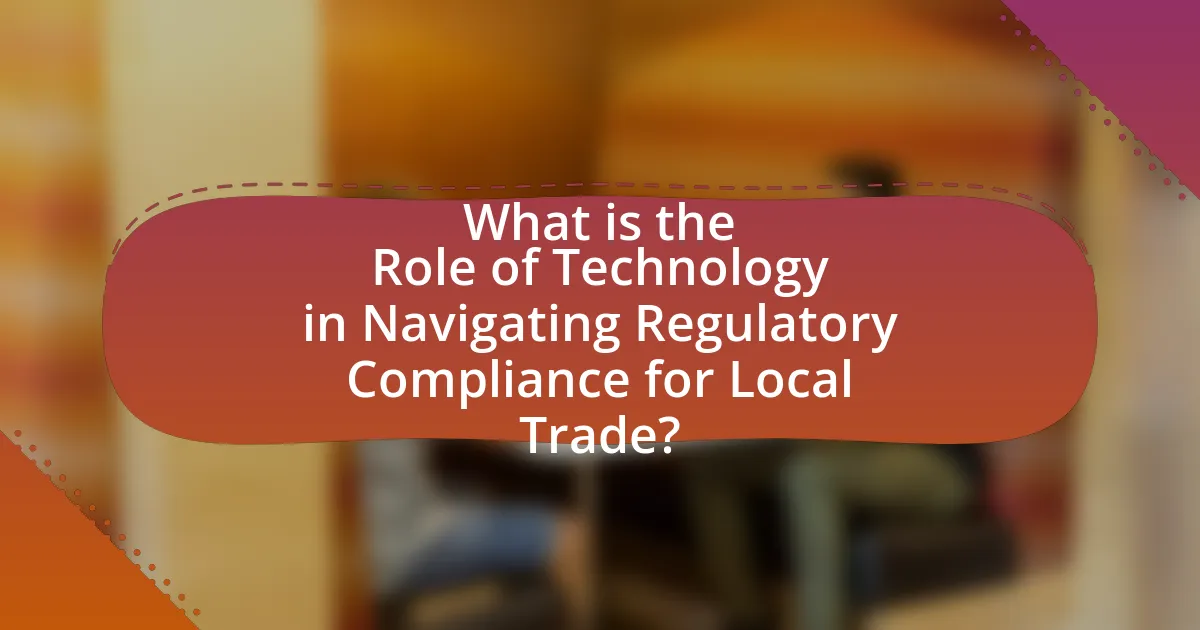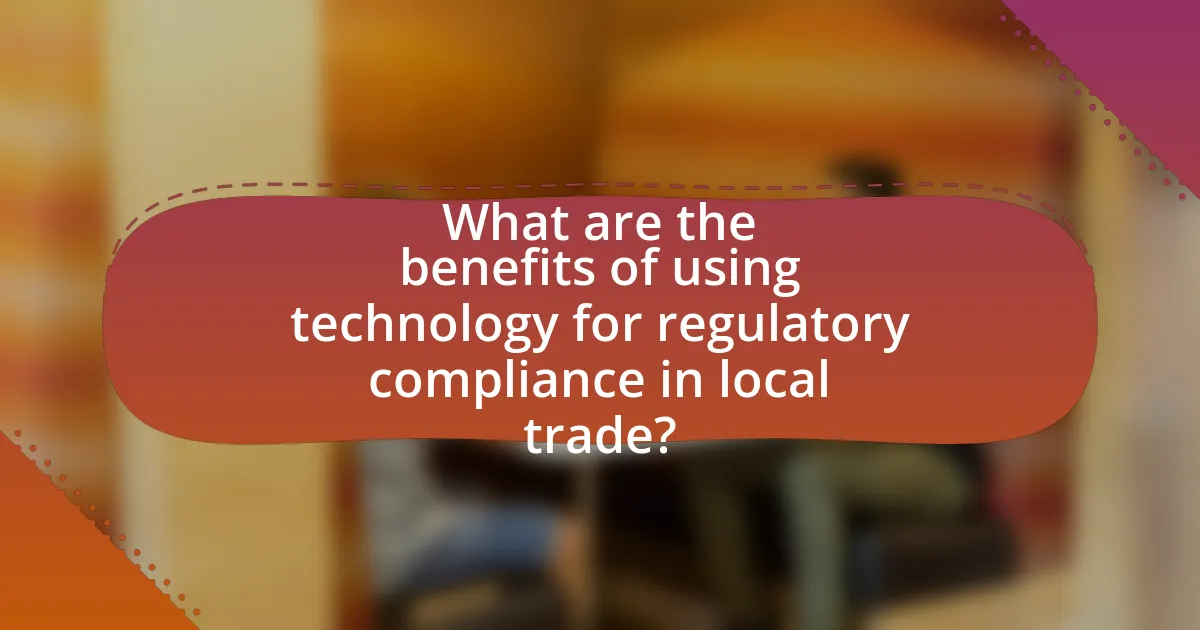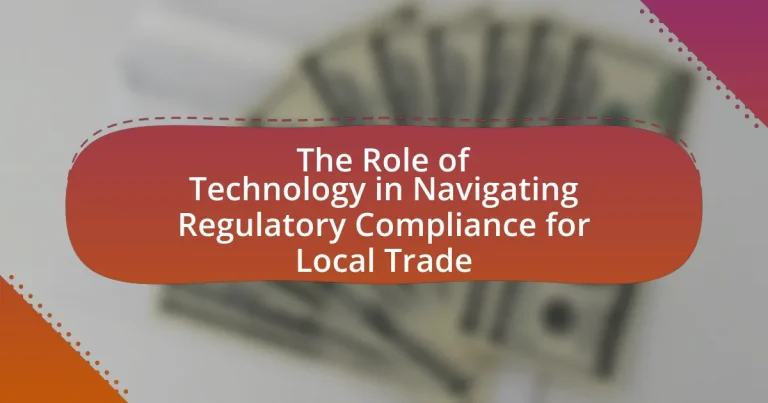The main entity of the article is the role of technology in navigating regulatory compliance for local trade. The article outlines how technology, including automation tools, compliance management software, and data analytics, enhances efficiency, accuracy, and transparency in compliance processes. It discusses specific technologies such as blockchain and electronic data interchange (EDI) that facilitate compliance, as well as the challenges local traders face in adhering to regulations. Additionally, the article highlights the financial benefits of implementing compliance technology, the importance of ongoing training, and emerging trends like artificial intelligence and blockchain in improving compliance practices.

What is the Role of Technology in Navigating Regulatory Compliance for Local Trade?
Technology plays a crucial role in navigating regulatory compliance for local trade by automating processes, ensuring accuracy, and providing real-time data analysis. Automation tools streamline documentation and reporting, reducing human error and enhancing efficiency. For instance, compliance management software can track regulatory changes and alert businesses to necessary adjustments, which is vital in dynamic regulatory environments. Additionally, data analytics tools enable businesses to analyze compliance metrics, ensuring adherence to local laws and regulations. According to a report by Deloitte, 60% of organizations that implemented compliance technology reported improved compliance outcomes, demonstrating the effectiveness of technology in this area.
How does technology facilitate regulatory compliance in local trade?
Technology facilitates regulatory compliance in local trade by automating processes, ensuring accurate record-keeping, and providing real-time data analysis. Automation reduces human error and streamlines compliance tasks, such as reporting and documentation, which are essential for meeting regulatory requirements. For instance, software solutions can automatically generate compliance reports based on transaction data, significantly reducing the time and effort needed for manual reporting. Additionally, technologies like blockchain enhance transparency and traceability in supply chains, allowing businesses to easily demonstrate compliance with local regulations. According to a 2021 study by the World Economic Forum, 70% of businesses using compliance technology reported improved adherence to regulations, highlighting the effectiveness of these technological solutions in facilitating compliance.
What specific technologies are used for compliance in local trade?
Specific technologies used for compliance in local trade include blockchain, electronic data interchange (EDI), and compliance management software. Blockchain technology ensures transparency and traceability in transactions, which is crucial for meeting regulatory requirements. EDI facilitates the automated exchange of business documents, reducing errors and ensuring adherence to trade regulations. Compliance management software helps businesses track and manage compliance obligations, providing tools for reporting and audits. These technologies collectively enhance efficiency and accuracy in maintaining compliance with local trade regulations.
How do these technologies improve efficiency in compliance processes?
Technologies improve efficiency in compliance processes by automating data collection and analysis, which reduces manual errors and speeds up reporting. For instance, regulatory technology (RegTech) solutions utilize machine learning algorithms to analyze vast amounts of data quickly, ensuring that organizations can meet compliance requirements in real-time. According to a report by Deloitte, companies that implement RegTech solutions can reduce compliance costs by up to 30% while improving accuracy and response times. This automation allows compliance teams to focus on strategic decision-making rather than routine tasks, ultimately enhancing overall operational efficiency.
Why is regulatory compliance important for local trade?
Regulatory compliance is crucial for local trade because it ensures that businesses operate within the legal framework, thereby fostering trust and stability in the marketplace. Compliance with regulations helps local traders avoid legal penalties, which can include fines or business shutdowns, and it promotes fair competition by establishing a level playing field. For instance, according to a report by the World Bank, countries with strong regulatory compliance frameworks experience higher levels of foreign investment and economic growth, indicating that adherence to regulations not only protects local businesses but also enhances their market opportunities.
What are the consequences of non-compliance in local trade?
Non-compliance in local trade can lead to significant legal and financial repercussions for businesses. These consequences include fines, penalties, and potential legal action from regulatory authorities, which can severely impact a company’s financial stability. For instance, the U.S. Small Business Administration reports that non-compliance can result in fines ranging from hundreds to millions of dollars, depending on the severity of the violation. Additionally, businesses may face reputational damage, leading to a loss of customer trust and decreased sales. This underscores the importance of adhering to local trade regulations to avoid detrimental outcomes.
How does compliance impact local businesses and economies?
Compliance significantly impacts local businesses and economies by ensuring adherence to laws and regulations, which fosters trust and stability in the market. When businesses comply with regulations, they reduce the risk of legal penalties and enhance their reputation, leading to increased customer loyalty and potentially higher sales. For instance, a study by the World Bank indicated that regulatory compliance can improve business performance by up to 30%, as it encourages fair competition and innovation. Furthermore, compliance contributes to economic growth by attracting investment, as investors prefer stable environments with clear regulatory frameworks. This creates jobs and stimulates local economies, demonstrating that compliance is essential for sustainable business practices and economic development.
What challenges do local traders face in regulatory compliance?
Local traders face significant challenges in regulatory compliance, primarily due to the complexity and variability of regulations across different jurisdictions. These traders often struggle to keep up with constantly changing laws, which can lead to unintentional non-compliance. For instance, a survey by the International Trade Centre found that 70% of small and medium-sized enterprises reported difficulties in understanding and adhering to regulatory requirements. Additionally, limited access to resources and technology further exacerbates these challenges, as many local traders lack the tools necessary to efficiently manage compliance processes. This combination of regulatory complexity and resource constraints creates a significant barrier for local traders in maintaining compliance.
How can technology address these challenges?
Technology can address the challenges of navigating regulatory compliance for local trade by automating compliance processes and providing real-time data analytics. Automation reduces human error and increases efficiency in tracking regulatory changes, while data analytics enables businesses to assess compliance risks and adapt swiftly to new regulations. For instance, software solutions like compliance management systems can streamline documentation and reporting, ensuring that businesses meet local trade regulations effectively. According to a report by Deloitte, companies that implement technology-driven compliance solutions can reduce compliance costs by up to 30%, demonstrating the tangible benefits of leveraging technology in this area.
What are the limitations of technology in ensuring compliance?
Technology has limitations in ensuring compliance due to factors such as data accuracy, adaptability to changing regulations, and the potential for cybersecurity threats. Data accuracy is crucial; if the information fed into compliance systems is incorrect or outdated, it can lead to non-compliance. Furthermore, regulations frequently evolve, and technology may not adapt quickly enough to incorporate these changes, resulting in gaps in compliance. Additionally, cybersecurity threats can compromise compliance systems, exposing sensitive data and leading to regulatory breaches. These limitations highlight the need for a balanced approach that combines technology with human oversight to effectively navigate regulatory compliance in local trade.
How does technology integrate with existing compliance frameworks?
Technology integrates with existing compliance frameworks by automating processes, enhancing data accuracy, and facilitating real-time monitoring. For instance, compliance management software can streamline the documentation and reporting required by regulations, reducing human error and ensuring timely submissions. Additionally, technologies such as artificial intelligence and machine learning can analyze vast amounts of data to identify compliance risks and trends, allowing organizations to proactively address potential issues. According to a report by Deloitte, 70% of organizations that implemented compliance technology reported improved efficiency in their compliance processes, demonstrating the effectiveness of technology in enhancing compliance frameworks.
What are the best practices for implementing technology in compliance processes?
The best practices for implementing technology in compliance processes include conducting a thorough needs assessment, selecting appropriate technology solutions, ensuring data security, providing comprehensive training, and continuously monitoring compliance effectiveness. A needs assessment identifies specific compliance requirements and gaps, guiding the selection of technology that aligns with regulatory standards. For instance, organizations often utilize compliance management software that automates reporting and tracking, which has been shown to reduce compliance-related errors by up to 30%. Ensuring data security is critical, as breaches can lead to significant penalties; according to IBM, the average cost of a data breach in 2023 was $4.45 million. Comprehensive training for employees on new technologies fosters a culture of compliance and enhances the effectiveness of the implemented solutions. Finally, continuous monitoring and evaluation of compliance processes using technology allow organizations to adapt to changing regulations and improve overall compliance performance.
How can local traders ensure successful technology adoption for compliance?
Local traders can ensure successful technology adoption for compliance by implementing comprehensive training programs for their staff. Training equips employees with the necessary skills to effectively use compliance-related technologies, which is crucial given that 70% of technology implementations fail due to lack of user adoption, as reported by the Project Management Institute. Additionally, local traders should conduct regular assessments of their technology systems to ensure they meet current regulatory standards, as compliance requirements can change frequently. This proactive approach not only minimizes the risk of non-compliance but also enhances operational efficiency.

What are the benefits of using technology for regulatory compliance in local trade?
Using technology for regulatory compliance in local trade enhances efficiency, accuracy, and transparency. Automated systems streamline compliance processes, reducing the time and resources required to meet regulatory requirements. For instance, electronic reporting tools minimize human error and ensure timely submissions, which can lead to fewer penalties and fines. Additionally, technology facilitates real-time monitoring and data analysis, allowing businesses to quickly adapt to changing regulations. A study by the World Bank indicates that digital compliance solutions can reduce compliance costs by up to 30%, demonstrating the significant financial benefits of adopting technology in this area.
How does technology enhance transparency in compliance?
Technology enhances transparency in compliance by automating data collection and reporting processes, which reduces human error and increases accuracy. For instance, compliance management software can track regulatory changes in real-time, ensuring that organizations are always aligned with current laws. This automation allows for consistent documentation and audit trails, making it easier to demonstrate compliance to regulators. Additionally, blockchain technology provides immutable records of transactions, further enhancing transparency by allowing stakeholders to verify compliance independently. According to a report by Deloitte, organizations that implement technology-driven compliance solutions experience a 30% reduction in compliance costs and improved visibility into their compliance status.
What role does data analytics play in compliance monitoring?
Data analytics plays a crucial role in compliance monitoring by enabling organizations to systematically analyze large volumes of data to identify patterns, anomalies, and potential compliance risks. This analytical capability allows businesses to proactively detect non-compliance issues, ensuring adherence to regulatory requirements. For instance, a study by the International Journal of Information Management found that companies utilizing data analytics for compliance monitoring experienced a 30% reduction in compliance-related incidents. This demonstrates that data analytics not only enhances the efficiency of compliance processes but also significantly mitigates risks associated with regulatory violations.
How can technology improve communication with regulatory bodies?
Technology can improve communication with regulatory bodies by facilitating real-time data sharing and enhancing transparency. Digital platforms enable businesses to submit compliance documents electronically, reducing processing times and minimizing errors associated with manual submissions. For instance, the use of Application Programming Interfaces (APIs) allows for seamless integration between business systems and regulatory databases, ensuring that information is up-to-date and accessible. According to a report by the World Economic Forum, digital tools can reduce compliance costs by up to 30%, demonstrating their effectiveness in streamlining communication and compliance processes.
What cost savings can be achieved through technology in compliance?
Technology in compliance can achieve significant cost savings by automating processes, reducing manual labor, and minimizing errors. For instance, automated compliance management systems can streamline data collection and reporting, which decreases the time and resources spent on compliance tasks. According to a study by the Aberdeen Group, organizations that implement compliance automation can reduce compliance costs by up to 30%. Additionally, technology can enhance data accuracy, leading to fewer penalties and fines associated with non-compliance, further contributing to overall cost savings.
How does automation reduce labor costs in compliance processes?
Automation reduces labor costs in compliance processes by streamlining repetitive tasks and minimizing human error. By implementing automated systems, organizations can handle data entry, monitoring, and reporting more efficiently, which reduces the need for extensive manual labor. For instance, a study by McKinsey & Company found that automation can reduce compliance-related labor costs by up to 30% by allowing employees to focus on higher-value tasks rather than routine compliance checks. This efficiency not only cuts costs but also enhances accuracy and compliance adherence, leading to further savings and risk mitigation.
What are the long-term financial benefits of investing in compliance technology?
Investing in compliance technology yields long-term financial benefits such as reduced operational costs, minimized risk of regulatory fines, and improved efficiency in compliance processes. Organizations that implement compliance technology can automate routine tasks, leading to significant labor cost savings; for instance, a study by Deloitte found that automation can reduce compliance costs by up to 30%. Furthermore, by ensuring adherence to regulations, companies can avoid costly penalties; the average fine for non-compliance can reach millions, as reported by the Global Compliance Survey. Additionally, compliance technology enhances data accuracy and reporting capabilities, which can lead to better decision-making and resource allocation, ultimately driving profitability.
How does technology support ongoing compliance training for local traders?
Technology supports ongoing compliance training for local traders by providing accessible, scalable, and interactive learning platforms. These platforms, such as Learning Management Systems (LMS), enable traders to access training materials anytime and anywhere, ensuring that they stay updated with the latest regulations and compliance requirements. For instance, online modules can be tailored to specific local regulations, allowing traders to focus on relevant content. Additionally, technology facilitates real-time assessments and feedback, which helps traders identify knowledge gaps and improve their understanding of compliance issues. According to a study by the International Compliance Association, organizations that utilize technology for compliance training report a 30% increase in knowledge retention compared to traditional methods.
What tools are available for compliance education and training?
Compliance education and training tools include Learning Management Systems (LMS), e-learning platforms, compliance software, and interactive training modules. These tools facilitate the delivery of compliance content, track employee progress, and ensure adherence to regulatory requirements. For instance, LMS platforms like Moodle and TalentLMS provide structured courses and assessments, while compliance software such as ComplyAdvantage offers real-time monitoring of regulatory changes. Interactive training modules, often incorporating gamification, enhance engagement and retention of compliance knowledge. These tools are essential for organizations to maintain compliance and mitigate risks associated with regulatory violations.
How can technology facilitate continuous learning in compliance practices?
Technology facilitates continuous learning in compliance practices by providing real-time access to regulatory updates and training resources. Digital platforms enable organizations to disseminate compliance information quickly, ensuring that employees stay informed about changes in laws and regulations. For instance, Learning Management Systems (LMS) can deliver tailored training modules that adapt to individual learning paces, enhancing knowledge retention. Additionally, data analytics tools can track employee progress and identify knowledge gaps, allowing for targeted interventions. A study by the International Compliance Association found that organizations utilizing technology for compliance training reported a 30% increase in employee engagement and understanding of compliance issues.

What future trends are emerging in technology and regulatory compliance for local trade?
Emerging trends in technology and regulatory compliance for local trade include the increased use of artificial intelligence (AI) for risk assessment and compliance monitoring, as well as the adoption of blockchain technology for enhanced transparency and traceability in transactions. AI systems can analyze vast amounts of data to identify compliance risks and automate reporting processes, thereby improving efficiency and accuracy. According to a report by Deloitte, 70% of organizations are investing in AI to enhance compliance capabilities. Additionally, blockchain technology allows for secure and immutable records of transactions, which can simplify audits and regulatory reporting. A study by PwC indicates that 45% of businesses are exploring blockchain solutions to improve compliance and reduce fraud risks. These trends reflect a shift towards more automated, data-driven approaches to regulatory compliance in local trade.
How is artificial intelligence shaping compliance processes?
Artificial intelligence is transforming compliance processes by automating data analysis, enhancing risk assessment, and improving regulatory reporting. AI systems can analyze vast amounts of data quickly, identifying patterns and anomalies that may indicate compliance risks. For instance, a study by Deloitte found that organizations utilizing AI for compliance saw a 30% reduction in compliance-related costs and a significant increase in the speed of reporting. This efficiency allows businesses to respond proactively to regulatory changes and maintain adherence to local trade regulations more effectively.
What are the potential risks associated with AI in compliance?
The potential risks associated with AI in compliance include data privacy concerns, algorithmic bias, and lack of transparency. Data privacy risks arise when AI systems process sensitive information, potentially leading to breaches of regulations like GDPR. Algorithmic bias can result in unfair treatment of individuals or groups if the training data is not representative, which can lead to compliance failures. Lack of transparency in AI decision-making processes can hinder accountability and make it difficult for organizations to demonstrate compliance with regulatory standards. These risks highlight the need for careful implementation and oversight of AI technologies in compliance contexts.
How can AI enhance decision-making in compliance management?
AI enhances decision-making in compliance management by automating data analysis and risk assessment, leading to more accurate and timely compliance decisions. For instance, AI algorithms can process vast amounts of regulatory data and identify patterns that human analysts might overlook, thereby improving the detection of compliance risks. According to a report by Deloitte, organizations that implement AI in compliance management can reduce compliance costs by up to 30% while increasing the speed of regulatory reporting. This efficiency allows compliance teams to focus on strategic decision-making rather than manual data processing, ultimately leading to better adherence to regulations and reduced risk of penalties.
What role does blockchain technology play in regulatory compliance?
Blockchain technology enhances regulatory compliance by providing transparent, immutable, and traceable records of transactions. This transparency allows regulators to access real-time data, ensuring adherence to laws and regulations. For instance, in the financial sector, blockchain can facilitate Know Your Customer (KYC) processes by securely storing customer identities and transaction histories, which can be easily verified by authorities. Additionally, the use of smart contracts automates compliance checks, reducing human error and increasing efficiency. According to a report by the World Economic Forum, blockchain could reduce compliance costs by up to 30% in certain industries, demonstrating its significant impact on regulatory adherence.
How can blockchain improve traceability in local trade compliance?
Blockchain can improve traceability in local trade compliance by providing an immutable and transparent ledger that records every transaction in real-time. This technology enables all parties involved in the trade process, including suppliers, manufacturers, and regulators, to access a single source of truth regarding the movement and status of goods. For instance, a study by the World Economic Forum highlighted that blockchain can reduce the time required for compliance checks by up to 80%, as it allows for instant verification of documentation and product origins. This enhanced visibility not only streamlines compliance processes but also helps in identifying and addressing discrepancies or fraud more effectively.
What are the challenges of implementing blockchain for compliance?
The challenges of implementing blockchain for compliance include regulatory uncertainty, integration with existing systems, and data privacy concerns. Regulatory uncertainty arises because blockchain technology is still evolving, leading to a lack of clear guidelines from authorities, which complicates compliance efforts. Integration with existing systems is challenging as organizations must adapt their current processes to accommodate blockchain, often requiring significant investment and technical expertise. Data privacy concerns stem from the transparent nature of blockchain, which can conflict with regulations like GDPR that mandate data protection and user privacy. These challenges highlight the complexities organizations face when adopting blockchain for compliance in local trade.
What practical steps can local traders take to leverage technology for compliance?
Local traders can leverage technology for compliance by implementing automated compliance management systems. These systems streamline the monitoring of regulatory changes and ensure adherence to local laws, reducing the risk of non-compliance. For instance, using software that integrates with existing business operations can provide real-time updates on regulatory requirements, enabling traders to adjust their practices promptly. Additionally, adopting electronic record-keeping solutions enhances data accuracy and accessibility, which is crucial for audits and inspections. According to a report by the International Trade Centre, businesses that utilize technology for compliance can reduce operational costs by up to 30%, demonstrating the effectiveness of these practical steps.
How can local businesses assess their technology needs for compliance?
Local businesses can assess their technology needs for compliance by conducting a thorough evaluation of their current systems against regulatory requirements. This involves identifying applicable regulations, such as data protection laws or industry-specific standards, and analyzing existing technology to determine gaps in compliance. For instance, a study by the International Association of Privacy Professionals indicates that 70% of organizations fail to meet data protection regulations due to inadequate technology solutions. By leveraging compliance assessment tools and consulting with compliance experts, businesses can pinpoint necessary upgrades or new technologies to ensure adherence to legal standards.
What resources are available for local traders to improve compliance through technology?
Local traders can improve compliance through technology by utilizing resources such as compliance management software, regulatory technology (RegTech) solutions, and online training platforms. Compliance management software, like ComplyAdvantage, helps traders automate compliance processes, monitor transactions, and manage risk effectively. RegTech solutions, such as those offered by Onfido, provide tools for identity verification and fraud prevention, ensuring adherence to regulatory requirements. Additionally, online training platforms, such as Coursera and LinkedIn Learning, offer courses on compliance regulations and best practices, enabling traders to stay informed and educated about their obligations. These resources collectively enhance compliance efforts by streamlining processes, reducing errors, and providing essential knowledge.



